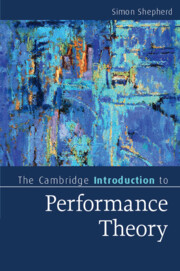Book contents
- Frontmatter
- Contents
- Preface
- Part I Definitions of performance
- Part II The emergence of performance as sensuous practice
- 6 Situationism, games and subversion
- 7 Hippies and expressive play
- 8 Performance as a new pedagogy
- 9 Architecture and the performed city
- 10 New forms of activism
- 11 Happenings and everyday performance
- 12 Body art and feminism
- 13 The arrival of Performance Art and Live Art
- 14 Dance party politics
- Part III Theorising performance
- Closing note
- References
- Index
- Cambridge Introductions to …
12 - Body art and feminism
from Part II - The emergence of performance as sensuous practice
Published online by Cambridge University Press: 05 February 2016
- Frontmatter
- Contents
- Preface
- Part I Definitions of performance
- Part II The emergence of performance as sensuous practice
- 6 Situationism, games and subversion
- 7 Hippies and expressive play
- 8 Performance as a new pedagogy
- 9 Architecture and the performed city
- 10 New forms of activism
- 11 Happenings and everyday performance
- 12 Body art and feminism
- 13 The arrival of Performance Art and Live Art
- 14 Dance party politics
- Part III Theorising performance
- Closing note
- References
- Index
- Cambridge Introductions to …
Summary
Crucial to the shaping of the concept and operation of performance in happenings were the stories told about the origins and aspirations of the art form. As we have seen, happenings could be positioned as works derived from, say, opposition to dominant order or simply as experiments in new art or theatre practice. In the same way, but perhaps with even greater lasting effects, the other major art initiative of the period was positioned by its genealogies.
In 1973 the art critic and journalist David Bourdon, writing about Vito Acconci, said that he was a major figure in ‘a new art movement known as body art’ (in Battcock and Nickas 1984: 187). As Bruce Barber shows, the term had become increasingly popular in art journals over the preceding years, appearing first around 1971/1972, while happenings had all but faded out by about 1975/1976.
The new movement, like happenings, appeared in both the United States and Europe more or less simultaneously. Its most startling early manifestation was in the work of those who cut open other bodies or damaged their own. In Hermann Nitsch's celebrated Blutorgie ‘he tore apart the cadaver of a freshly slain lamb [and] also gave a learned lecture on the “liberation of violent urges through catharsis”’ (report from 1966 in Hunter and Bodor 2012: 71). In Chris Burden's performances between 1971 and 1975, among other things, ‘he imprisoned himself in a locker, crawled nearly naked across broken glass in a city street, had a steel stud nailed into his sternum, had pins pushed into his stomach’ (Loeffler 1980: 398). In an effort to categorise the new work the art magazine Avalanche published an essay in 1970 called ‘Body Works’, by which it meant works that ‘present physical activities, ordinary bodily functions and other usual and unusual manifestations of physicality’ (in Barber 1979: 192). Assumptions about what ‘ordinary’ and ‘usual’ might mean were, however, subject to challenge, and that challenge, driven by a very specific political imperative, made body works, quite as much as happenings, a potential site of contestation and new thinking.
It is autumn 1971 in California. A group of students is listening to Allan Kaprow. He suggests that a good exercise to prepare for doing a performance piece might be to sweep the floor.
- Type
- Chapter
- Information
- The Cambridge Introduction to Performance Theory , pp. 117 - 121Publisher: Cambridge University PressPrint publication year: 2016



